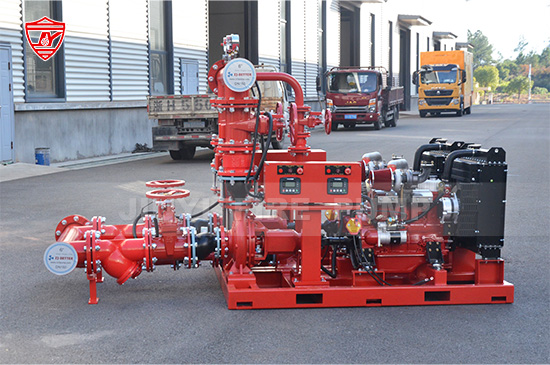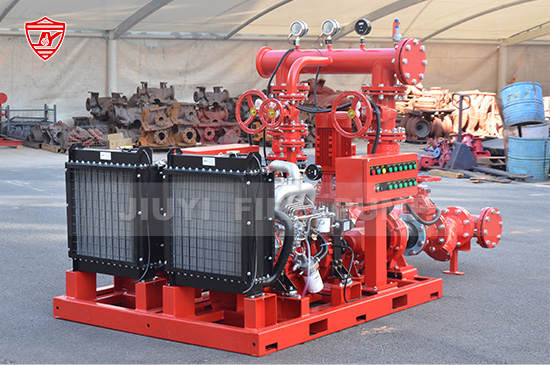Hydrostatic testing is one of the most essential safety procedures in fire pump manufacturing. It verifies whether a pump can safely withstand pressures significantly higher than those it will encounter during real fire emergencies. For fire pumps that seek UL listing, hydrostatic testing must meet strict requirements defined by UL 448: Standard for Centrifugal Stationary Pumps for Fire Protection. This standard ensures that every UL listed fire pump casing, component, and assembly has the structural strength required to operate reliably in high-pressure firefighting scenarios.
As a global manufacturer of fire pumps, we conduct UL hydrostatic testing as part of our mandatory quality control process. This article explains what the UL standard requires, how hydrostatic testing is performed, why it is critical for fire pump safety, and how it differs from other testing procedures in the fire protection industry.

Hydrostatic testing is a pressure-based strength test used to confirm that the pump casing and related components will not leak, deform, or rupture under elevated pressures. In simple terms, it is a controlled over-pressurization test that pushes a fire pump beyond its working limits to ensure structural integrity.
During a hydrostatic test, the pump casing is filled with water and pressurized to a level far greater than its rated operating pressure. This allows the manufacturer to detect potential risks early, including:
casting defects
material weaknesses
porosity or micro leak points
improper assembly
machining inconsistencies
For UL listed fire pumps, the hydrostatic test is not optional — it is a mandatory part of certification.
The UL standard clearly defines the pressures at which each fire pump component must be tested. These requirements depend on the pump’s rated working pressure.
The UL 448 standard requires fire pump casings to withstand three times the pump’s rated maximum working pressure, or 500 psi, whichever is higher.
For example:
A pump rated at 150 psi must be hydrostatically tested at 450 psi.
A pump rated at 250 psi must be tested at 750 psi, but if this is below 500 psi, the minimum 500 psi rule applies.
For high-pressure fire pumps (300–350 psi), the test pressure will exceed 900–1050 psi and is strictly monitored.
This elevated test ensures that the fire pump casing will remain safe even under unexpected surges or system anomalies.
UL requires the test to be conducted for a minimum of 5 minutes at full test pressure. During this time:
no visible leakage is allowed,
no permanent deformation is permitted,
no cracking or structural failure can occur.
Test records must be documented and traceable for auditing or compliance review.
UL 448 requires not just the casing but also specific internal components to undergo hydrostatic testing. These may include:
bearing housings
pressure-containing covers
water passages
welded structures
flanges and bolt connections
All components must withstand the designated test pressure without signs of damage.
While each manufacturer may have its own internal testing workflow, UL hydrostatic testing typically includes the following steps:
Before pressurizing the pump, technicians inspect the casing for casting defects, machining irregularities, or material inconsistencies. This reduces risk and increases accuracy.
All inlet/outlet openings are sealed using high-strength test plugs or flanges. Pressure gauges and relief valves are installed to monitor and control pressure.
Water is used because it is incompressible, which makes it safer than air for pressure testing. The pump is filled slowly to remove trapped air bubbles, preventing test errors.
Pressure is increased slowly and evenly using a hydrostatic test pump. This measured approach keeps the casing safe from sudden shock loads.
The pump must remain at the full UL test pressure for the required duration. During this time, inspectors check for:
weeping spots
micro leaks
flange leaks
deformation
pressure loss
abnormal sounds or structural movement
After the test, pressure is reduced carefully and the pump is drained. A second detailed inspection confirms the casing’s integrity.
UL requires complete documentation of:
test pressure
test duration
inspection results
technician approvals
equipment used
pump serial numbers
This ensures long-term traceability.
The hydrostatic test is not merely a procedure for certification — it directly impacts fire safety. The fire pump is the heart of a building’s fire protection system, and any structural weakness could become catastrophic during a fire emergency.
Fire pumps must operate during emergencies when system pressures fluctuate, valves open and close rapidly, and hydrant demand surges. Hydrostatic testing verifies that the pump can handle these stresses.
Defects such as porosity, cracks, or weak points in the casting cannot always be seen with the naked eye. Hydrostatic testing reveals weaknesses before the pump leaves the factory.
UL listing is recognized in more than 100 countries, providing assurance that the fire pump meets one of the world’s strictest safety standards.
A structurally sound fire pump ensures uninterrupted water supply during fire suppression efforts, safeguarding lives, buildings, and critical infrastructure.
Although UL and NFPA are separate standards, UL hydrostatic testing aligns with NFPA 20 requirements for fire pump acceptance and performance reliability.
Many users confuse hydrostatic testing with performance testing, but they serve different purposes.
Verifies the structural integrity of the casing
Uses water to test at extreme pressures
Required before any performance test
Does not evaluate flow or head
Evaluates pump curve, head, flow, and efficiency
Checks 100%, 150%, and churn performance
Conducted at rated operating pressure
Ensures pump meets its hydraulic design
Both tests are required for UL certification, but hydrostatic testing focuses strictly on physical strength.
Manufacturers that follow UL hydrostatic test standards typically achieve higher product reliability and customer trust. The process leads to measurable improvements:
By testing every casing at extreme pressures, the manufacturer ensures consistent quality throughout all production batches.
Pumps that pass UL hydrostatic testing rarely experience pressure-related failures during installation or long-term operation.
Projects such as airports, petrochemical plants, hospitals, and high-rise buildings rely on pumps that can handle sustained high pressures. UL testing ensures this capability.
Some pumps fail the hydrostatic test on the first attempt. Common causes include:
casting porosity or thin walls
improper machining
gasket surface imperfections
weak flange connections
welding defects
incorrect assembly of test fixtures
When failures occur, UL requires corrective action, redesign, or recasting before final approval.
UL listed fire pumps go through more rigorous testing than non-UL pumps. This gives:
higher safety confidence
easier project approvals
smoother inspections
reduced liability
longer pump lifespan
Many international projects now require UL listed pumps as a mandatory specification.

The UL standard for fire pump hydrostatic testing is one of the most critical elements of UL certification. By requiring every pump casing and pressure-bearing component to withstand pressures many times higher than their rated working conditions, UL ensures the pump’s long-term safety, reliability, and performance.